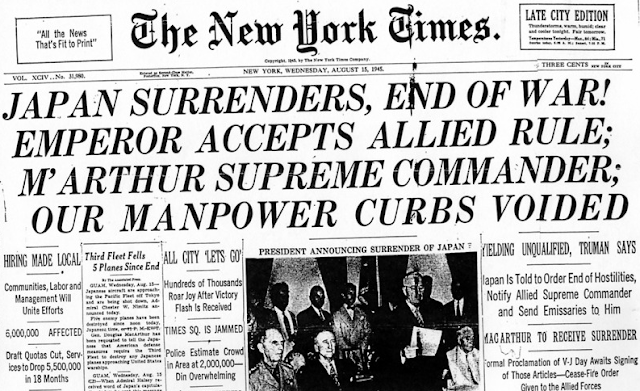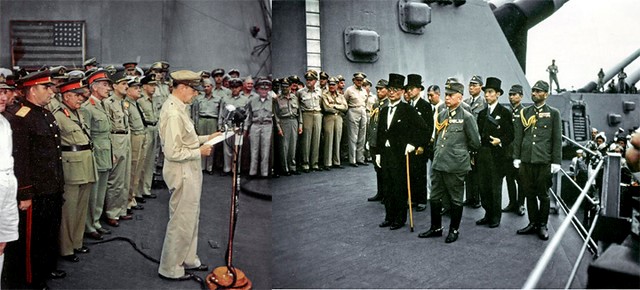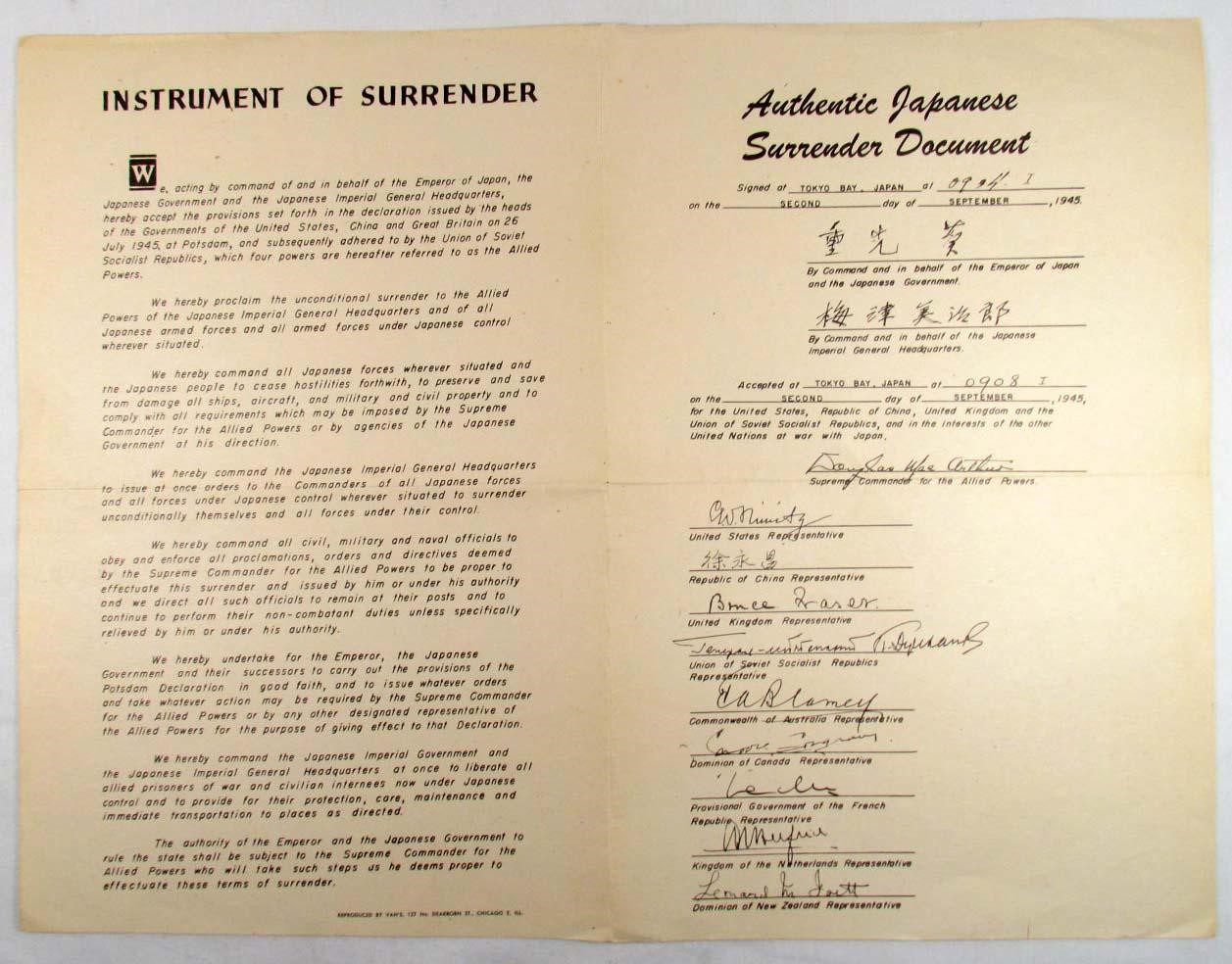We celebrate that historic day 75 years ago (September 2, 1945) when Japan’s unconditional surrender ceremony on the USS Missouri officially ended World War II, which for the United States officially began when Congress issued a formal declaration of war on December 8, 1941.
Three days later, Hitler declared war on the United States on December 11, 4 days after Japan’s surprise attack on Pearl Harbor left the U.S. Pacific Fleet gravely wounded. Hitler’s declaration challenged the United States with a war on two fronts.
U.S. forces fought bravely on both fronts, but gave first priority to the European front — and U.S. allied forces achieved Germany’s unconditional surrender on May 8, 1945, Victory in Europe (VE) Day.
Then, U.S. and allied forces focused on defeating Japan and were planning an invasion expected to cost millions of lives — from our allied forces and among the Japanese. But that conflict was cut short when Japan’s emperor surrendered unconditionally on August 14, 1945, in the wake of the historic August 6th and 9th bombings on Hiroshima and Nagasaki — the first and so far only use of atonic (nuclear) weapons.
Following that Victory in Japan — (VJ) Day, America’s celebrations began, from the streets of the smallest towns to the largest, e.g., in New York City.
Below is a photograph on the USS Missouri Battleship, of General of the Army Douglas Macarthur addressing the Japanese delegation led by Japan’s Foreign Minister Mamoru Mhigemitsu and the Chief of the Japanese Army General Staff, General Yoshijiro Umezu. They subsequently signed the formal instrument of unconditional surrender, also shown below. That surrender was accepted by General Macarthur and also signed by representatives of our allies in the Pacific.
Thus ended the Second World War that formally began on December 8, 1941 — about three months less that four years earlier. That success was due to the courage and will of what has become known as “The Greatest Generation.” With the formal conclusion of World War II, most of America’s “citizen” soldiers, sailors, marines and airmen returned to their families to build the global economic and military power we have since enjoyed.
But now America is again under threat from other global powers. And as has been observed by key Department of Defense (DOD) authorities, we are again playing “catch-up,” this time with threats posed by our World War II allies, Russia and especially China.
Ironically, they now pose existential threats; and our World War II enemies, Germany and Japan, are now allies.
The rising generation appears to have little memory of the values, traditions and competence that so underpinned America’s success in that formative era that left America as the unequaled global power. And now America, while claiming to retain that power, risks losing the benefits of that past era, as we witness mobs in our streets challenging all that most Americans have held dear since our founding.
I have witnessed this transition up close and personal. As a young farm boy during World War II, I listened with my family to the daily radio reports of the battles and tracked them as best we could on maps that we obtained; and we sketched on them the progress (and losses) of the allies. We prayed for God’s provision for them and our leaders while working with our neighbors to provide sustance for all Americans and our allies in that global struggle.
I traveled each Monday with my dad to drill in our County Seat with the Home Guard. (He was too old for active duty but was charged to help prepare for possible invasion.) And I learned how to respond if we were invaded. Pulling the shades down to hide from air attack was a daily ritual for relatives who lived in cities — some of whom led formal Civil Defense activities.
While employing rationed goods, I learned how to patch synthetic rubber tires that blew out regularly, gathered scrap metal to be melted into bullets and other armaments, wore shirts my mother sewed from feedbags, and took regular precautions against the possibility of invasion. We had regular drills in grade school on how to seek safety rapidly. I learned how to take care of my rifle and to use it safely and accurately — to help with food and if needed protection. And in 1944, numerous gliders landed in fields around our farmhouse, training for their D-Day role in the Normandy invasion.
Young men left high school and college to fight to protect us all. Early on, some recruits had to drill with “broomsticks” because of a shortage of rifles — and all our fighting forces where short of the weapons and systems they needed to fight a war on two fronts, as indicated above. When they went to war, their wives and girlfriends took “Rosie the Riviter” places in America’s factories to build essentially from scratch the weapon systems we needed to fight and win in Europe and the Pacific — in three months short of four years! And I’ll not forget the ladies who served, e.g., as nurses and WACS and WAVES on active duty!
I still have Navy issued shoes given to me by a cousin who served — and which became my spit-shined dress shoes when I was a Clemson Cadet — I wore them in our wedding, and have told my wife I want to be buried with them on.
By the time I was a Clemson student, many veterans from World War II and Korea were taking advantage of the G.I. Bill and lived on campus in prefabs, while raising their young families. And they were competitive student engineers!
When I joined Bell Telephone Laboratories, I worked with a number of other Vets who engaged in developing the information and other technologies that underpin today’s 5G systems (and beyond) as well as the first ballistic missile defense systems — which introduced me to the EMP threat that still concerns me greatly because it has been mostly ignored by the current “powers that be.”
But some of the Greatest Generation learned how to protect against the EMP threat, at least to protect our most important military systems; but they did not protect our critical civil infrastructure — e.g., to provide electricity that is essential for all our vital infrastructure that provides emergency management, timely effective communications, essential fuel support, support for hospitals and essential water-wastewater infrastructure, etc. Sadly, our current leaders have not yet figured out how to use those long-ago vital lessons-learned to protect the American people.
Then there’s “space,” where we are playing “catch-up” with threatening technology being developed by Russia and especially China. And while the Pentagon has stood up the President’s Space Force in the Air Force, it is moving ever so slowly toward initiating all aspects of the needed Space Force, as illustrated by disagreements even over the Ranks of officers in the Space Force, discussed with intended humor in my recent Newsmax article included below.
___________________________________________________________________________________
Dissension Over the Ranks at Space Force
By Henry F. Cooper Newsmax, Thursday, 27 August 2020 01:16 PM https://www.newsmax.com/henryfcooper/spaceforce-ranks/2020/08/27/id/984156/ What the heck is wrong with you, Space Force?
What the heck is wrong with you, Space Force?
According to the August 25 Stars and Stripes and August 26 Military Times, William Shatner of Star Trek fame is asking this question to the “very esteemed members of the U.S. Space Force” and other “U.S. Government poohbahs.” He is referring to a dispute over the ranks of President Trump’s new Space Force — and his preferences, of course. And a decision seems to be on hold.
Shatner is referring to his fictional Star Trek role, first as Captain of the Starship Enterprise and then Admiral James Tiberius Kirk as Commander of Star Fleet Operations. It should not have been an unanticipated question, given the similarity of the logos for U.S. Space Force the fictional Star Fleet Command.
A major difference, of course, is that the U.S. Space Force operates under another service, the U.S. Air Force, which in turn reports to the Joint Chiefs and has an important acquisition and advisory role.
Since the 1986 Goldwater-Nichols Act intended to overcome previous intra-service rivalry and reinforce the principal of civilian control of the military, the nation’s operations commands report through the Secretary of Defense to the U.S. Commander in Chief, the U.S. president.
This chain of command implies that the U.S. Space Command is several tiers below how the fictional Starfleet command reported — to a fictional United Federation of Planets, presumably in which a unified Earth Command would be a member of a “United Federation of Planets” — a distant future possibility?
Still, Kirk’s — pardon me, Shatner’s — question is a good one, reflecting an ongoing debate, no doubt prompted in part by the fact that the Space Force is currently embedded in the U.S. Air Force.
Therefore, the Air Force wants the Space Force to employ the rank structure (e.g., colonels and generals) it adopted from the U.S. Army when it was formed as a separate service in 1947, following its World War II role as the Army Air Corps. (Though the Air Force has Squadrons, Groups and Wings and the Army has Companies, Battalions and Regiments.)
Retired USAF Lt. General David Deptula implicitly argues for this outcome in his August 16, The Hill article, “Let the Space Force Decide Its Own Ranks.”
General Deptula’s article appears to have been prompted to counter an amendment to the National Defense Authorization Act for 2021 — NDAA(2021), proposed by Rep. Dan Crenshaw (R-Texas), a proud Navy hero, and his amendment requires the newly established space orbiteers to use Navy ranks and grades — e.g., captains and admirals.
William Shatner, alias James T. Kirk, agrees with Rep. Crenshaw, of course.
However this argument comes out, all the current services should play important roles in the U.S. Space Force … and have a historical basis for doing so.
The USAF space activities were initiated by Gen. Bernard “Benny” Schriever — and a brand-new team established in Southern California. Key to his Atlas, Titan and Minuteman rapid development and deployment activities was USAF Gen. Sam Phillips, who led the development of the staging technology that was essential in meeting President Kennedy’s May 25, 1961 challenge to land a man on the moon and to return him safely to Earth by the end of the 1960s — he led NASA’s Apollo team that achieved that goal ahead of schedule.
Thus, the Army and Air Force space activities have been apparent for decades. Indeed, Gen. Schriever served in the Army Air Corps before and during World War II. And his key “lieutenant” in beginning the Air Force’s Space capabilities, Gen. Sam Phillips, also served in the Army Air Corps during World War II.
While the Navy connection may be less apparent, the Navy has been involved in exploring space from the beginning. Its Vanguard program lost out to the Army’s (Von Braun’s) Redstone efforts in placing our first satellite in orbit — but it also has been active in developing, deploying and operating satellites and its sea-launched ballistic missiles (SLBMs) since the late ’50s.
And once the super-secret National Reconnaissance Office (NRO) was formed in 1961, it has played a very important role in developing cutting-edge technology for associated intelligence-gathering space missions.
Thus, it should not surprise anyone that there may be some discord in assigning “Space Force” roles and ranks, especially from the various long-existing service responsibilities, authorities and operations.
And I didn’t mean to leave out the Marines — recall that John Glenn, our first astronaut to orbit the Earth, was a Marine. I’m not sure of a prior Coast Guard role, but there may be an analogous one among future Space Force missions.
Notably, the Marines, embedded in the Navy, employs the same rank structure as the Army, e.g. colonels and generals, whereas the Coast Guard employs the Navy’s rank structure — captains and admirals.
Whatever, the fact that the U.S. Space Force is currently embedded in the U.S. Air Force does not preclude the constructive involvement of the other services. Dealing with the separate interservice history is one of many challenges — one that is, in my opinion, made more difficult than it would have been if the U.S. Space Force had been set up as a separate service.
It will be interesting to see how long before the “powers that be” see the merits of a separate service — recall it took World War II to make that case clearly enough for those “powers that were” to set up a separate USAF from the Army Air Corps.
I hope it won’t take another global war to make that happen.
_________________________________________________________________________
Click here for a perspective from Brent Zlarnick, an assistant professor of national security studies at the Air Command and Staff College at Maxwell Air Force Base in Alabama. His views are representative of a well-informed Air Force cadre who believe that there is good reason for adopting Navy Ranks for future space operations.
Understand that much more than the rank of Space Force leaders is contentious as the “powers that be” form this much needed service. Needed are strategy, plans, capabilities and operations for the U.S. Space Force — and soon!
As we contemplate those requirements, we should recall that the Congressional Commission to Assess United States National Security Space Management and Organization observed twenty years ago that there were limited senior Air Force leaders qualified to lead the formation of the then recognized need for a U.S. Space Force.
Click here for that report that is still pertinent because, in my opinion, little has changed since then — in fact, there was almost immediately an important regression when U.S. Space Command was disestablished on the heels of that important report, and only after almost two decades has that mistake been corrected.
That history and future prospects will be the subject of future messages. In particular, that important and unheeded Commission warned of a future “Pearl Harbor in Space” that, in my opinion, we may soon confront unless we change our ways.
Bottom Lines.
As we remember and celebrate the formal end of World War II, it is worthwhile to reflect on the “Greatest Generation” that from a “standing start” defeated two authoritarian powers that sought world domination — and ironically turned them into allies that stand with us today against two of our World War II allies.
As we honor the 18-year-olds who went to war to protect our homeland — and justifiably gained for the current generation of 18-year-olds the right to vote — it is also ironic to see so many of them among the mob in the streets of our major cities. It is hard to escape the conclusion that our generation, who lived through that transition, have failed to pass to them the values of our Fathers and Mothers of the Greatest Generation.
What will future generations call ours?
What can you do?
Join us in praying for our nation, and for a rebirth of the freedom sought, achieved and passed to us by those who came before us.
Help us to spread our message to the grass roots and to encourage all “powers that be” to provide for the common defense as they are sworn to do.
Begin by passing this message to your friends and suggest they visit our webpage www.highfrontier.org, for more information. Also, please encourage your sphere of influence to sign up for our weekly e-newsletter.
Encourage them to review our past email messages, posted on www.highfrontier.org, to learn about many details related to the existential man-made and natural EMP threats and how we can protect America against them. I hope you will help us with our urgently needed efforts, which I will be discussing in future messages.
Click here to make a tax deductible gift. If you prefer to mail a check, Please send it High Frontier, 20 F Street 7th Floor, Washington, DC 20001.
E-Mail Message 200902
Please click here to read Past Weekly Updates!
Please help High Frontier continue this important and timely work!
Be sure to follow us on our Social Sites!
If you found this letter via our Social Sites, and you would like to subscribe, please click below!








